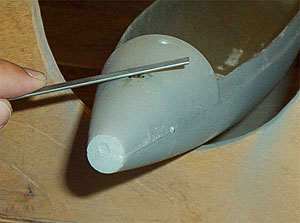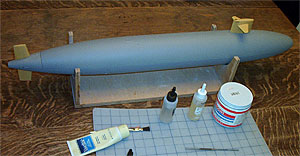|
RUDDERS
- Bearing Installation
|
|
1.
At left are the necessary raw materials for installing
the rudder bearings: 2 hour epoxy (not shown), tape,
mixing cup, Vaseline, 5 minute epoxy.
NOTE:
While 5 minute epoxy is not to be used for joining materials
to be exposed to water, because of its rapid drying
properties it can be used to tack pieces in place prior
to gluing with more suitable adhesives.
|
|
|
2.
First, apply a thin film of Vaseline to each rudder
shaft to prevent gluing it to the bearings. Place the
bearings on the rudder shafts. Prepare a small batch
of 5 minute epoxy in a cup. Using a toothpick, place
a small drop of 5 minute epoxy on each bearing and insert
it into the hull (be sure to use the middle tubing piece
to connect the rudder shafts as depicted in step 9 of
the previous
page).
|
 |
3.
Secure the rudders in place with masking tape. It is
best to support the lower rudder. Use the sail's trailing
edge as a sight guide to help ensure proper alignment.
Allow the 5 minute epoxy to cure completely.
|
|

|
4.
Carefully remove the tape and rudders. Mix a batch
of 2 hour cure epoxy and micro-balloons (see section
2 "Hull
Assembly" for
mixing instructions). Using a Q-tip, apply a bead of
epoxy/micro-balloons around each bearing. Be sure to
fill any gaps between the hull and bearing. Avoid getting
epoxy in the bearing itself.
It
is best to reinstall the rudders (don't forget a thin
film of Vaseline) and shaft connecting tubing and re-tape
the rudders to ensure accurate final alignment. Set
the hull aside and allow to cure overnight.
|
 |
5.
With the epoxy completely cured and the bearings bonded
firmly to the hull, a small flat file can be used to shape
any part of the bearing which is exposed above the hull
contour. |
 |
6.
Slip the rudders in their respective bearings and check
for fit and movement. They should rest snugly and evenly
against the hull. Each rudder should freely turn at
least 35° past the centerline both to port
and starboard. If either rudder piece is found to bind
during movement (binding usually occurs when passing
center), use a small flat file and shape it until the
necessary freedom of travel is achieved.
NOTE:
setting up the rudder control linkages will be covered
in section 7.
|
 |
7.
By now your model is beginning to take shape. The next
section will combine the techniques you've already mastered
and will cover the installation of the stern diving planes... |
| |
Stern
Planes
|
|
|
Not
So Fast...
While
5 minute epoxy was used to tack the bearings in this
section, it's rapid dry time may be a little too
fast depending on your skill level and confidence. Several
different epoxies are available with varying cure times
up to 30 minutes. Feel free to use them if needed. However,
always finish the bonding process with 2 hour slow cure
epoxy.
|
|



